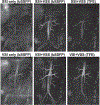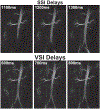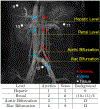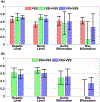Non-contrast-enhanced abdominal MRA at 3 T using velocity-selective pulse trains
- PMID: 32017173
- PMCID: PMC7263981
- DOI: 10.1002/mrm.28187
Non-contrast-enhanced abdominal MRA at 3 T using velocity-selective pulse trains
Abstract
Purpose: Most existing non-contrast-enhanced methods for abdominal MR arteriography rely on a spatially selective inversion (SSI) pulse with a delay to null both static tissue and venous blood, and are limited to small spatial coverage due to the sensitivity to slow arterial inflow. Velocity-selective inversion (VSI) based approach has been shown to preserve the arterial blood inside the imaging volume at 1.5 T. Recently, velocity-selective saturation (VSS) pulse trains were applied to suppress the static tissue and have been combined with SSI pulses for cerebral MR arteriography at 3 T. The aim of this study is to construct an abdominal MRA protocol with large spatial coverage at 3 T using advanced velocity-selective pulse trains.
Methods: Multiple velocity-selective MRA protocols with different sequence modules and 3D acquisition methods were evaluated. Sequences using VSS only as well as SSI+VSS and VSI+VSS preparations were then compared among a group of healthy young and middle-aged volunteers. Using MRA without any preparations as reference, relative signal ratios and relative contrast ratios of different vascular segments were quantitatively analyzed.
Results: Both SSI+VSS and VSI+VSS arteriograms achieved high artery-to-tissue and artery-to-vein relative contrast ratios above aortic bifurcation. The SSI+VSS sequence yielded lower signal at the bilateral iliac arteries than VSI+VSS, reflecting the benefit of the VSI preparation for imaging the distal branches.
Conclusion: The feasibility of noncontrast 3D MR abdominal arteriography was demonstrated on healthy volunteers using a combination of VSS pulse trains and SSI or VSI pulse.
Keywords: abdominal MRA; arteriography; non-contrast-enhanced MRA; velocity-selective pulse train.
© 2020 International Society for Magnetic Resonance in Medicine.
Figures









Similar articles
-
Whole-brain arteriography and venography: Using improved velocity-selective saturation pulse trains.Magn Reson Med. 2018 Apr;79(4):2014-2023. doi: 10.1002/mrm.26864. Epub 2017 Aug 10. Magn Reson Med. 2018. PMID: 28799210 Free PMC article.
-
Cerebral blood volume mapping using Fourier-transform-based velocity-selective saturation pulse trains.Magn Reson Med. 2019 Jun;81(6):3544-3554. doi: 10.1002/mrm.27668. Epub 2019 Feb 8. Magn Reson Med. 2019. PMID: 30737847 Free PMC article.
-
Comparison of velocity-selective arterial spin labeling schemes.Magn Reson Med. 2021 Apr;85(4):2027-2039. doi: 10.1002/mrm.28572. Epub 2020 Oct 31. Magn Reson Med. 2021. PMID: 33128484 Free PMC article.
-
[Diagnosis of renal artery stenosis with magnetic resonance angiography and stenosis quantification].J Mal Vasc. 2000 Dec;25(5):312-320. J Mal Vasc. 2000. PMID: 11148391 Review. French.
-
[Contrast-enhanced three-dimensional angiography].Nihon Igaku Hoshasen Gakkai Zasshi. 2000 Aug;60(9):493-9. Nihon Igaku Hoshasen Gakkai Zasshi. 2000. PMID: 11019576 Review. Japanese.
Cited by
-
Three-dimensional whole-brain mapping of cerebral blood volume and venous cerebral blood volume using Fourier transform-based velocity-selective pulse trains.Magn Reson Med. 2021 Sep;86(3):1420-1433. doi: 10.1002/mrm.28815. Epub 2021 May 6. Magn Reson Med. 2021. PMID: 33955583 Free PMC article.
-
Whole-Neck Non-Contrast-Enhanced MR Angiography Using Velocity Selective Magnetization Preparation.Tomography. 2022 Dec 29;9(1):60-69. doi: 10.3390/tomography9010006. Tomography. 2022. PMID: 36648993 Free PMC article.
-
Ensuring both velocity and spatial responses robust to field inhomogeneities for velocity-selective arterial spin labeling through dynamic phase-cycling.Magn Reson Med. 2021 May;85(5):2723-2734. doi: 10.1002/mrm.28622. Epub 2020 Dec 8. Magn Reson Med. 2021. PMID: 33349968 Free PMC article.
-
Test-retest reliability of 3D velocity-selective arterial spin labeling for detecting normal variations of cerebral blood flow.Neuroimage. 2023 May 1;271:120039. doi: 10.1016/j.neuroimage.2023.120039. Epub 2023 Mar 16. Neuroimage. 2023. PMID: 36931331 Free PMC article.
-
Prostate perfusion mapping using Fourier-transform based velocity-selective arterial spin labeling: Choice of cutoff velocity and comparison with brain.Magn Reson Med. 2023 Sep;90(3):1121-1129. doi: 10.1002/mrm.29695. Epub 2023 May 19. Magn Reson Med. 2023. PMID: 37203405 Free PMC article.
References
-
- Laissy JP, Trillaud H, Douek P. MR angiography: noninvasive vascular imaging of the abdomen. Abdom Imaging. 2002;27:488–506. - PubMed
-
- Prince MR. Gadolinium-enhanced MR aortography. Radiology. 1994;191:155–164. - PubMed
-
- Prince MR, Narasimham DL, Stanley JC, et al. Breath-hold gadolinium-enhanced MR angiography of the abdominal aorta and its major branches. Radiology. 1995;197:785–792. - PubMed
-
- Hany TF, Debatin JF, Leung DA, Pfammatter T. Evaluation of the aortoiliac and renal arteries: comparison of breath-hold, contrast-enhanced, three-dimensional MR angiography with conventional catheter angiography. Radiology. 1997;204:357–362. - PubMed
Publication types
MeSH terms
Substances
Grants and funding
LinkOut - more resources
Full Text Sources

